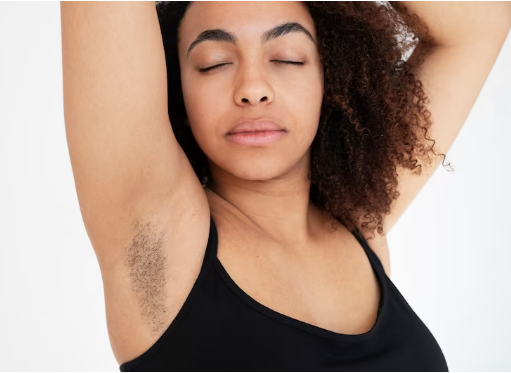
What Is The Function Of Armpit Hair?
Armpit hair, like body hair in general, serves several functions, although its importance and significance have evolved over time and may vary among individuals and cultures. Some of the primary functions of armpit hair include:
-
Temperature Regulation: One of the main functions of body hair, including armpit hair, is to help regulate body temperature. The hair acts as insulation, trapping heat close to the body during colder conditions and helping to dissipate heat when it’s warmer.
-
Sweat and Odor Absorption: Armpit hair can help absorb and hold onto sweat produced by the apocrine glands in the armpits. This can prevent sweat from immediately evaporating and, in combination with bacteria present on the skin, contribute to body odor.
-
Friction Reduction: Armpit hair can help reduce friction between the arms and the torso during movement, making certain activities more comfortable.
-
Protection: In some cases, armpit hair may provide a degree of protection to the delicate skin of the underarms.
-
Pheromones and Sexual Attraction: Some researchers suggest that body hair, including armpit hair, might play a role in distributing and retaining pheromones, which are chemical substances that can influence social and sexual interactions.
However, it’s essential to note that the significance of armpit hair varies across different cultures and personal preferences. In many modern societies, there is a strong cultural emphasis on hair removal, especially for women, as a beauty standard or for hygienic reasons. Shaving or trimming armpit hair is common in many parts of the world.
Ultimately, whether one chooses to keep, trim, or remove armpit hair is a personal decision. There are no inherent health risks associated with having or not having armpit hair, and individuals should feel free to make choices based on their comfort, cultural norms, and aesthetic preferences.
Ingrown Hair Under Armpit
Ingrown hair under the armpit, medically known as “pseudofolliculitis axillaris” or “razor bumps,” is a common condition that occurs when hair curls back or grows sideways into the skin. It often leads to painful, inflamed bumps that can be bothersome and uncomfortable. While ingrown hairs can affect anyone, they are more prevalent in individuals with curly or coarse hair and those who frequently shave, wax, or pluck their underarm hair. This article explores the causes, symptoms, prevention, and treatment options for ingrown hair under the armpit.
Causes and Symptoms
Ingrown hairs occur when the sharp tip of a hair follicle reenters the skin, leading to irritation, inflammation, and the formation of small, painful bumps. The most common causes of ingrown hair under the armpit are:
-
Hair Removal Techniques: Shaving, waxing, or plucking armpit hair can create sharp edges on the hair shaft, making it more likely to grow back into the skin instead of growing out naturally.
-
Curly or Coarse Hair: Curly or coarse hair is more prone to curl back into the skin after removal, increasing the risk of ingrown hair formation.
-
Clogged Hair Follicles: Dead skin cells and debris can block hair follicles, causing the hair to grow sideways under the skin.
The symptoms of ingrown hair under the armpit may include:
- Red, inflamed bumps resembling small pimples
- Itching and discomfort
- Pain or tenderness in the affected area
- Darkening of the skin (hyperpigmentation) around the ingrown hair site
Prevention Tips
While it may be challenging to entirely prevent ingrown hairs, the following tips can help minimize the risk:
-
Proper Hair Removal Techniques: If you choose to remove underarm hair, opt for proper shaving techniques such as using a sharp, clean razor and shaving in the direction of hair growth.
-
Exfoliation: Regularly exfoliate the underarm area to remove dead skin cells and reduce the likelihood of hair follicle blockages.
-
Avoid Tight Clothing: Wearing tight-fitting clothing can cause friction and further irritate the underarm area, potentially contributing to ingrown hair formation.
-
Avoid Over-Grooming: Limit excessive plucking, waxing, or shaving, as frequent hair removal can increase the likelihood of ingrown hairs.
Treatment Options
If you already have ingrown hair under your armpit, there are several effective treatment options:
-
Warm Compress: Applying a warm compress to the affected area can help soothe inflammation and promote hair follicle release.
-
Topical Creams: Over-the-counter creams containing hydrocortisone or glycolic acid can help reduce inflammation and exfoliate the skin, allowing the ingrown hair to emerge.
-
Avoid Picking or Squeezing: Resist the temptation to pick or squeeze the ingrown hair, as this can lead to infection and worsen the condition.
-
Antibacterial Ointment: If the area becomes infected, applying an antibacterial ointment can help prevent further complications.
-
Allow Hair to Grow: If possible, consider allowing the hair to grow naturally for a while to prevent further irritation and give the ingrown hair a chance to resolve.
Conclusion
Ingrown hair under the armpit can be uncomfortable and irritating, but with proper care and treatment, it can often be managed effectively. Avoiding frequent hair removal, using proper techniques when grooming, and practicing good hygiene can significantly reduce the risk of developing ingrown hairs. If you experience persistent or severe symptoms, or if the ingrown hair becomes infected, it’s advisable to seek medical advice from a dermatologist for appropriate diagnosis and treatment.


